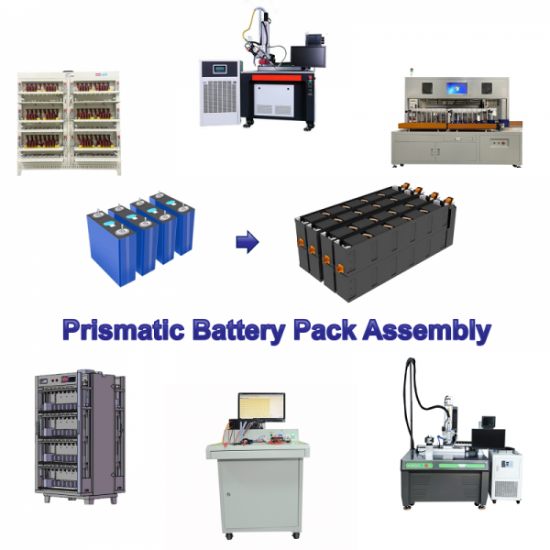Lith Corporation, founded in 1998 by a group of material science doctor from Tsinghua University, has now become the leading manufacturer of battery lab&production equipment. Lith Corporation have production factories in shenzhen and xiamen of China.This allows for the possibility of providing high quality and low-cost precision machines for lab&production equipment,including: roller press, film coater,mixer, high-temperature furnace, glove box,and complete set of equipment for research of rechargeable battery materials. Simple to operate, low cost and commitment to our customers is our priority.
What is a Car Battery Fabrication Line?
A Car Battery Fabrication Line refers to the integrated set of manufacturing processes and equipment used to produce battery cells for electric vehicles (EVs), hybrid electric vehicles (HEVs), and plugin hybrid electric vehicles (PHEVs). It encompasses all stages from raw material preparation to cell assembly, formation, and testing.
This line is typically part of a larger battery production ecosystem, which may also include module and pack assembly lines. The fabrication line focuses specifically on celllevel manufacturing, which is the most critical and complex part of the overall process due to its impact on performance, safety, cost, and scalability.
Depending on the level of automation and scale, this can range from labscale prototyping lines to semiautomated pilot lines and finally to fully automated highvolume gigafactory lines.
Key Objectives of a Car Battery Fabrication Line
1. Produce HighQuality Battery Cells at Scale
Ensure consistent electrochemical performance
Meet automotivegrade standards for reliability and longevity
2. Enable Mass Production Efficiency
Maximize throughput with minimal downtime
Reduce waste and improve yield rates
3. Support Multiple Battery Chemistries and Formats
Accommodate NMC, LFP, solidstate, sodiumion, etc.
Support pouch, prismatic, cylindrical, and novel form factors
4. Ensure Safety and Process Control
Maintain clean and dry environments during critical steps
Implement realtime monitoring and traceability
5. Optimize for Cost and Sustainability
Reduce energy consumption and raw material waste
Enable recycling and closedloop material recovery
6. Facilitate Technology Transfer and Innovation
Allow integration of new materials and designs
Enable process improvements through data analytics and AI
Stages in a Car Battery Fabrication Line
The fabrication line consists of several interconnected stages that transform raw materials into fully functional battery cells.
1. Material Preparation and Slurry Mixing
Cathode and anode powders are mixed with solvents, binders, and conductive agents
Slurries are homogenized using planetary mixers or highshear systems
Quality checks ensure uniformity and viscosity
2. Electrode Coating
The slurry is applied onto current collectors:
Aluminum foil for cathodes
Copper foil for anodes
Slotdie coating or doctorblade methods are commonly used
Thickness and coating quality are monitored with laser sensors
3. Drying and Calendering
Electrodes are dried in ovens to remove solvents (e.g., NMP)
Drying must occur in controlled humidity and temperature conditions
After drying, electrodes are compressed using calendering machines to achieve desired density and porosity
4. Slitting and Cutting
Electrodes are cut into precise widths using slitting machines
Edge quality and dimensional accuracy are crucial for stacking or winding
Dust extraction systems prevent contamination
5. Stacking or Winding
Two main approaches:
Stacking: Used mainly for pouch and prismatic cells; layers of positive and negative electrodes are stacked with separators
Winding: Used for cylindrical cells; jellyroll configuration created by winding electrodes and separator together
Automated robotic systems ensure precision and alignment
6. Cell Assembly
The electrode stack or wound jelly roll is inserted into a cell housing (pouch, metal can, or prismatic case)
Separator placement and internal connections are verified
Tabs are welded to terminals using laser welding or resistance welding
7. Electrolyte Filling and Sealing
Must be done in a dry room environment (<1% RH) to avoid moisture contamination
Electrolyte is injected precisely into the cell
Cell is sealed immediately after filling to prevent exposure to air
8. Formation and Aging
First charge/discharge cycle ("formation") activates the cell chemistry
Cells undergo aging under controlled conditions to stabilize performance
Formation data is recorded for traceability and sorting
9. Testing and Sorting
Electrical tests measure capacity, internal resistance, and voltage stability
Mechanical tests check for leaks, seal integrity, and structural strength
Cells are sorted based on performance metrics before shipping or further assembly
Types of Car Battery Fabrication Lines
Fabrication lines can vary significantly depending on the battery type, scale, and automation level:
1. LabScale Fabrication Line
Manual operations, small batches
Focus: research, material testing, proofofconcept
Equipment: gloveboxes, small coaters, manual stackers
2. Pilot Fabrication Line
Semiautomated, flexible setup
Focus: process development, validation, smallscale trials
Equipment: modular machines, MESintegrated systems
3. Mass Production Fabrication Line
Fully automated, highspeed systems
Focus: gigafactorylevel output (GWh/year)
Equipment: continuous coating lines, robotic winders, AIcontrolled systems
Supporting Infrastructure in a Car Battery Fabrication Line
To ensure safe and efficient operation, several critical support systems must be integrated:
1. Clean Room & Dry Room Systems
Ultralow humidity zones for electrolyte filling and electrode handling
HEPA filtration to remove particulates
Climate control for optimal process conditions
2. Fire Safety and Explosion Protection
Gas detection systems for solvent vapors
Inert gas blanketing in mixing and drying areas
Fire suppression systems with clean agents or water mist
Prismatic Cell Assembly Line
3. Digital Manufacturing and Traceability
MES (Manufacturing Execution System) – Realtime process tracking
IoT sensors and PLCs – Monitor pressure, temperature, humidity
AIbased vision systems – Detect defects in coatings and welds
Traceability systems – Track each cell from raw materials to shipment
4. Sustainability and Waste Management
Solvent recovery systems – Reuse of NMP
Battery recycling integration – Closedloop material recovery
Energyefficient HVAC and lighting
Water treatment systems – For cleaning and process water
5. Automation and Robotics
Automated conveyor systems – Move materials and components
Robotic arms – Handle electrodes, stack components, load/unload machines
Laser welding and cutting – Highprecision joining and trimming
Smart testing systems – Autosort cells based on test results
Applications of a Car Battery Fabrication Line
Car battery fabrication lines are essential across various sectors:
1. Battery Manufacturers
Producing cells for OEMs and EV brands
Developing proprietary technologies and chemistries
2. Automotive OEMs
Vertical integration of battery production
Customization of battery packs for vehicle platforms
3. Startups and Innovators
Scaling up new battery technologies
Attracting investment and strategic partnerships
4. Government and Industrial Parks
Building local battery supply chains
Supporting national electrification strategies
5. Tier 1 Suppliers
Supplying modules and packs to OEMs
Integrating BMS, cooling, and safety systems
Benefits of a Car Battery Fabrication Line
Enables largescale production of EV batteries
Reduces dependency on external suppliers
Supports innovation in battery chemistry and design
Improves cost efficiency and product consistency
Strengthens local industrial ecosystems
Promotes sustainability and circular economy practices
Provides competitive advantage in the EV market
Leading Companies Involved in Car Battery Fabrication Line Development
Here are some key global players involved in designing, building, and operating car battery fabrication lines:
Battery Manufacturers:
CATL (China) – World’s largest EV battery supplier
BYD (China) – Blade battery technology
Panasonic (Japan) – Partner to Tesla for cylindrical cells
Samsung SDI (South Korea) – Highenergydensity solutions
ACC (France) – European battery cell manufacturer
Research Institutions:
Fraunhofer Institute (Germany) – Advanced battery production R&D
Argonne National Laboratory (USA) – Materials and process innovation
KRICT (South Korea) – Battery chemistry and pilotscale work
CSIRO (Australia) – Sustainable battery development
Equipment and Automation Providers:
KUKA (Germany) – Robotic automation
Siemens (Germany) – Digital twin and MES platforms
Trumpf, IPG Photonics (Global) – Laser welding and cutting
Hanson Robotics, Gree EnergyTech (China) – Integrated battery line solutions
B&R Automation (ABB subsidiary) – Smart manufacturing systems
Engineering and EPC Firms:
Bechtel, Hatch, Black & Veatch (Global) – Turnkey plant construction
Wood, Jacobs, GHD (Global) – Engineering and sustainability consulting
Need Help Designing or Optimizing Your Car Battery Fabrication Line?
If you're looking to build, expand, or optimize your car battery fabrication line, I can help you with:
Master planning – Site selection, process flow, zoning
Process engineering – Battery chemistry, format, and production stages
Factory layout design – Clean/dry room integration, workflow
Equipment sourcing – Bestinclass machinery and automation
Sustainability strategy – Green energy, recyclability, circular economy
Cost estimation and ROI analysis – CapEx, OpEx, breakeven modeling
Compliance and safety systems – Fire protection, permits, worker safety
All you need to do is provide the following information:
Battery chemistry and cell format (e.g., NMC, LFP, solidstate, pouch)
Target annual production capacity (e.g., 10–100 MWh/year or more)
Plant location and available infrastructure
Level of automation and digitalization desired
Current team expertise and strategic goals




 Online service
Online service
